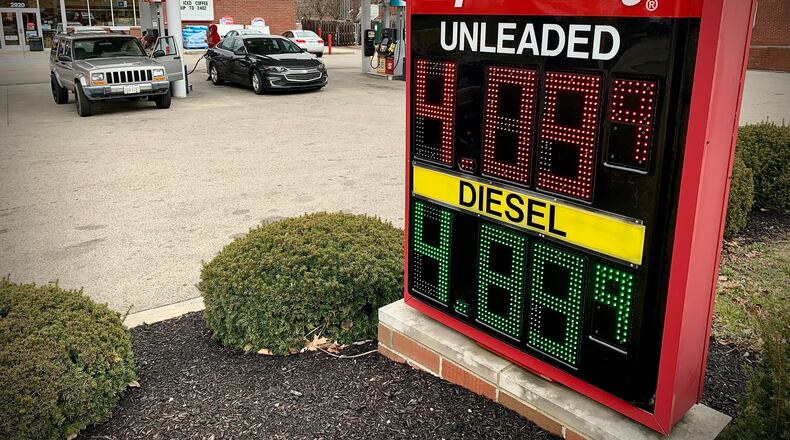The national average of $4.104 gallon set a national record, eclipsing 2008′s record of $4.10 a gallon, according to Patrick De Haan, head of petroleum analysis for GasBuddy.com. The higher prices this time will likely stay around far longer, DeHaan said.
DeHaan said the national average has risen 49.1 cents a gallon in the last seven days, the largest seven-day rise in history, surpassing the 49 cents a gallon rise after Hurricane Katrina.
Inflation had caused gas prices to rise this year, but the Russian invasion of Ukraine prompted the latest surges in prices. During the first full week of Russia’s invasion of Ukraine, the price of regular gas rose by almost 41 cents, according to the AAA motor club.
That represents the second largest single-week jump in the national average gas price, GasBuddy reported.
“As Russia’s war on Ukraine continues to evolve and we head into a season where gas prices typically increase, Americans should prepare to pay more for gas than they ever have before,” De Haan, said in a statement.
The all-time national high for average gasoline prices was set in July 17, 2008 at $4.10 per gallon. AAA.com said the highest price in the Dayton region for a gallon of regular unleaded gas was $4.17 a gallon on May 4, 2011. The highest price for a gallon of diesel was $4.75 a gallon on July 18, 2008.
In Ohio, the average price for a gallon of gasoline as of early Monday afternoon was $3.832, while the average price for a gallon of diesel was reported at $4.646, according to AAA.com.
On Monday morning, some local stations were selling gas for 20 to 30 cents less until the prices spiked in the afternoon.
The cheapest places to buy a gallon of gasoline as of 3 p.m. Monday were reported on GasBuddy.com at a BP station on West Main Street in Tipp City for $3.69/gallon; a BP station on Kettering Boulevard in Kettering; a Shell station on East Staunton Road in Troy; and a Marathon station on East Staunton Road in Troy.
In addition to setting a new all-time high, the national average is seeing its largest ever seven-day spike: 49.1 cents per gallon, eclipsing the 49.0 cent weekly rise after Hurricane Katrina in 2005. Many gas price records have been broken due to Russia’s war on Ukraine, which has pushed Western countries to impose severe sanctions on Russia, curbing Russian exports of crude oil to the global market.
On Saturday, the U.S. national average gas price surpassed $4 per gallon for the first time since 2008, and Friday’s spike alone came close to the record daily rise of 18 cents per gallon, increasing nearly 16 cents per gallon in one day. Diesel prices, however, did break records on Friday, as diesel soared to its largest daily gain ever: 22.2 cents per gallon, 6 cents higher than the previous record from 2013.
“Americans have never seen gasoline prices this high, nor have we seen the pace of increases so fast and furious. That combination makes this situation all the more remarkable and intense, with crippling sanctions on Russia curbing their flow of oil, leading to the massive spike in the price of all fuels: gasoline, diesel, jet fuel and more,” De Haan said. “It’s a dire situation and won’t improve any time soon. The high prices are likely to stick around for not days or weeks, like they did in 2008, but months. GasBuddy now expects the yearly national average to rise to its highest ever recorded.”
The dramatic increase in gas prices also made it hard to keep up with the constant changes of prices at the pump. De Haan also Tweeted the GasBuddy.com app to help people find cheap gas continued “to struggle under a tremendous amount of traffic, we are working feverishly to scale up.”
Last week, the International Energy Agency (IEA) announced a coordinated release of crude oil from its 31 member countries’ strategic reserves, including the U.S., Germany, Canada, South Korea, and Mexico, to help counter the impact of rising crude prices.
On Friday, IEA said member states committed to releasing a total of 61.7 million bbl from their strategic reserves to reassure markets roiled by the fallout from Russia’s invasion of Ukraine. This amount—half of which is expected to come from the U.S.—is the largest coordinated release since IEA was founded in 1974.
Despite this announcement, the impact on pricing has been limited given that the amount of oil planned for release is small in comparison to the amount that flows daily from Russia to other countries around the globe. According to IEA, Russia exports approximately 5 million b/d of crude oil, representing about 12% of its global trade.
According to new data from the Energy Information Administration (EIA), total domestic gasoline stocks decreased by 500,000 bbl to 246 million bbl last week. Meanwhile, gasoline demand rose slightly from 8.66 million b/d to 8.74 million b/d.
The increase in gas demand and a reduction in total supply contribute to rising pump prices. But, increasing oil prices play a leading role in pushing gas prices higher. Consumers can expect the current trend at the pump to continue as long as crude prices climb.
The Associated Press contributed to this story.
About the Author
